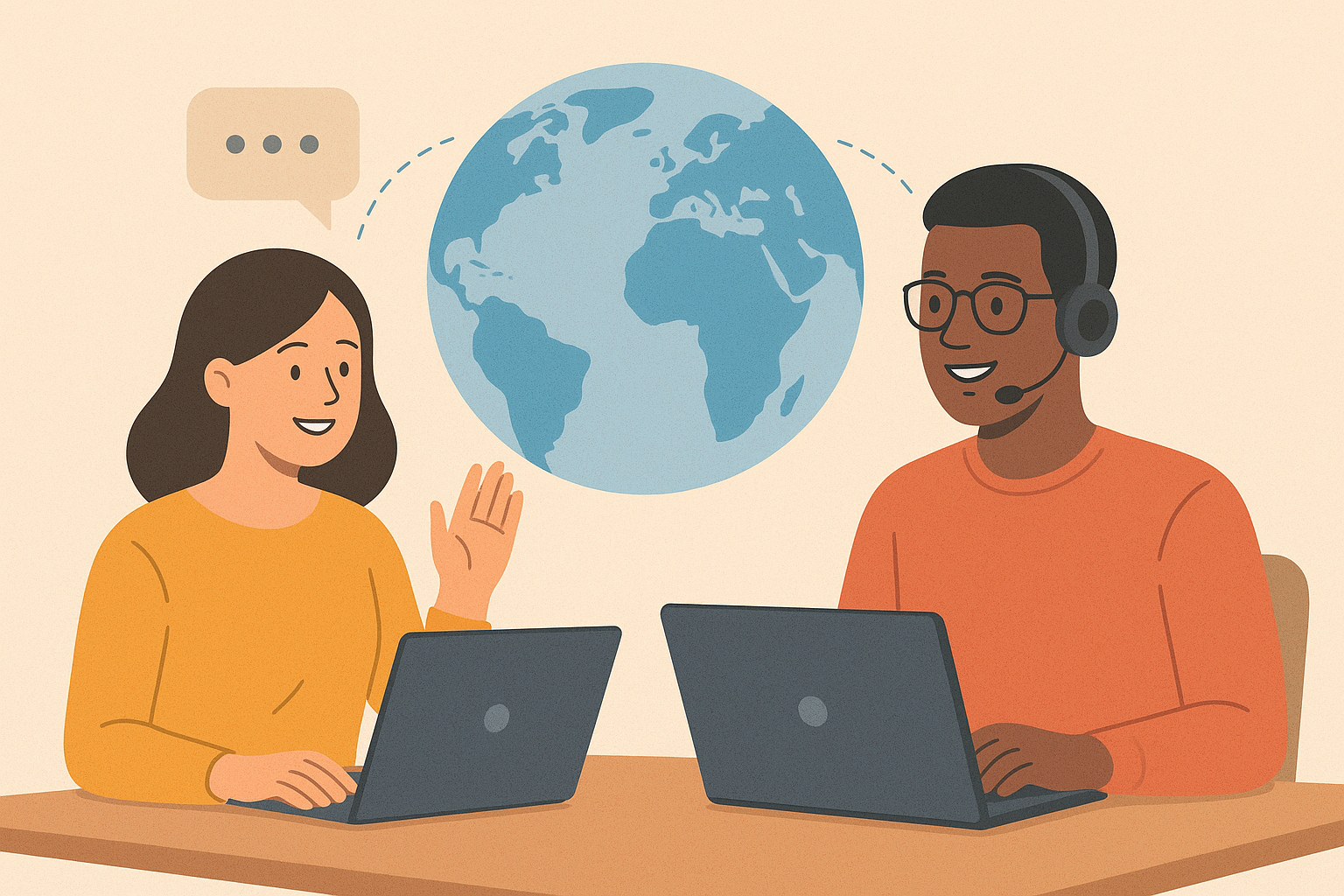Can a short online process turn your course work with peers abroad into proof that matters to employers?

Virtual exchange lets learners work on real projects with peers at universities across the world. Institutions embed these collaborations into courses and track participation so outcomes match clear benchmarks.
At Georgia State, more than 3,000 learners joined virtual exchange in 2024–2025, and the University of Florida uses this model to grow cultural awareness and cross-border teamwork. Completing these projects often results in an official, verifiable credential you can share with employers today.
This online pathway saves time by turning course activity into recognized evidence. It highlights teamwork, project delivery, and intercultural engagement — not just attendance.
Read on to see how the process verifies your participation, links to institutional records, and supports your goals with practical help at every step.
What a Digital Student Exchange Certificate Is and Why It Matters Today
Universities now issue an official record that captures teamwork, timelines, and results from course-based global collaboration. This record confirms you completed a virtual exchange project with peers around the world and that your work met faculty standards.

The credential verifies specific learning outcomes from VE/COIL-style courses. These include intercultural communication, shared problem-solving, and cross-institution collaboration guided by instructors.
“Collaborative Online International Learning develops digital literacy and cultural awareness through course-embedded teamwork.”University of Florida
| Format | Common Outcomes | Proof Included |
|---|---|---|
| Synchronous class sessions | Live teamwork, time-zone coordination | Participation logs, project deliverables |
| Asynchronous modules | Reflected learning, written communication | Discussion records, graded tasks |
| Small-group projects | Project management, shared outputs | Final report, faculty verification |
Why it matters now: employers and grad programs want verified global perspectives and proof of teamwork across disciplines. The record complements institutional badges and transcripts by offering a standardized, portable summary of work done in courses.
Benefits and Skills Your Digital Student Exchange Certificate Proves
A verified record from a virtual exchange shows concrete skills employers value. It turns course work and team outputs into clear proof of what you can do in real settings.

Intercultural communication and collaboration
The credential signals intercultural communication and cross-border collaboration. It documents that you negotiated meaning, managed time zones, and worked toward shared deliverables.
Global perspectives and cultural awareness
Institutions record how projects built cultural awareness and broadened perspectives. That evidence shows you can incorporate multiple viewpoints into project decisions responsibly.
Career-ready competencies
The record lists career-ready skills: time management, project design, and platform literacy. It also captures reflective evaluation and the ability to meet academic timelines.
Resume-ready recognition
Your validated experience can be added to LinkedIn, portfolios, and applications. Employers see applied results, not just course attendance.
Learning with peers around the world
Working with peers in another region teaches planning, task division, and delivery under constraints. Those team-based achievements—co-authored reports or joint presentations—translate to internships and entry roles.
How to Get Your Digital Student Exchange Certificate
If you completed a COIL or VE project in any course, you can apply to have that work confirmed and shared.
Eligibility and participation
Applicants should have finished a faculty-led virtual exchange or COIL project embedded in their courses. Projects must include assessed assignments completed with peers around world and instructor oversight.
Submission steps
Prepare evidence: course enrollment proof, timelines, and final outputs (reports, presentations, media).
- Gather project briefs, team rosters, and milestone records.
- Request instructor or partner faculty verification of deliverables.
- Complete the online application describing your role and contributions.
Processing timelines and accepted settings
Applications open after VE completion within the academic term. Processing follows course calendars so you can list the record in near-term applications.
“Educational coordinators help plan, validate, and streamline submissions for timely recognition.”Know My World
| Format | Accepted | Typical Evidence |
|---|---|---|
| Synchronous class sessions | Yes | Participation logs, recorded meetings |
| Asynchronous modules | Yes | Discussion records, graded tasks |
| Hybrid group projects | Yes | Final reports, faculty verification |
Support and planning
Ask coordinators and partner universities early. They can confirm participation, validate deliverables, and provide statements that speed review.
Conclusion
Turn your cross-border project work into an official record that highlights practical skills and global awareness. This trusted recognition converts virtual exchange experience into verified proof of learning, communication, and collaboration employers and schools accept.
The record matters because it documents applied skills gained in real projects with peers across countries and cultures. It captures planning, time management, and project delivery as part of your academic experience.
Paired with a VE badge, the record boosts portability and credibility on resumes, portfolios, and LinkedIn. Organize evidence, confirm instructor verification, and submit online to meet deadlines.
If you need help, coordinators and partner faculty can guide verification and keep your application on track. Consolidate your documentation and apply now to display your skills to the world.
FAQ
What is a digital student exchange certificate and who issues it?
A digital exchange certificate is an official record that verifies completion of a virtual exchange or COIL (Collaborative Online International Learning) project. Universities, study abroad offices, and recognized international programs such as the Institute of International Education or partner colleges typically issue the credential in electronic form for easy sharing.
Which skills does this certificate demonstrate to employers and schools?
The credential highlights intercultural communication, teamwork with peers around the world, project design, time management, and digital literacy. It shows practical experience collaborating across time zones and cultures—skills valued by U.S. institutions and global employers alike.
How do I become eligible to receive one?
Eligibility usually requires active participation in a confirmed virtual exchange or COIL course, completion of assigned collaborative projects, and submission of required documentation. Check your program’s eligibility rules and speak with your faculty coordinator or international office for specifics.
What documents do I need to submit when applying?
Common submissions include course completion proof, a portfolio or project report, peer evaluation summaries, and a short reflection on learning outcomes. Most programs provide an online application portal that outlines required files and formats.
How long does processing take and when will I receive the certificate?
Processing timelines vary by institution but often range from two to eight weeks after final grades or project verification. Institutions align issuance with academic terms, so plan for possible delays around breaks and exam periods.
Can I add the certificate to my resume and LinkedIn profile?
Yes. The credential is designed for resume and LinkedIn use. Include the issuing institution, dates, and a brief line about the project focus—such as intercultural collaboration or global project management—to show relevance to recruiters.
Are these certificates recognized internationally and by U.S. colleges?
Many partner universities and U.S. institutions acknowledge verified virtual exchange credentials, especially when programs follow established standards and include learning outcomes. Verify recognition with admissions offices when using the certificate for credit or transfer purposes.
What support is available if I have questions during the application?
Support often comes from program coordinators, faculty leads, and international student offices. They can guide you through documentation, technical uploads, and appeals. Contact details are usually listed in the exchange program materials or online portal.
Can group projects count toward the certificate requirements?
Yes. Collaborative projects with peers from partner institutions commonly form the core evidence for the credential. Submit project deliverables, contributor roles, and peer assessments to document participation and learning.
How does participation benefit classroom learning and future opportunities?
Virtual exchanges expand cultural awareness and introduce new perspectives into coursework. They build transferable competencies that improve candidacy for internships, graduate programs, and global careers. Institutions value applicants who show practical experience working across cultures and disciplines.




